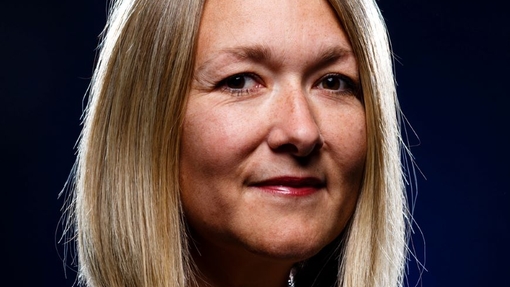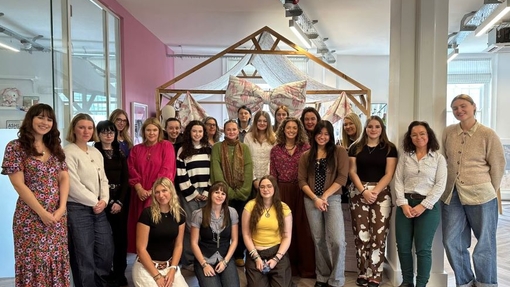The Power of Collaboration: How Creative Arts and Industry Partnerships Shape Future-Ready Graduates
Georgia McKie, Programme Manager for Surface Pattern and Textiles at Swansea College of Art, UWTSD, is passionate about preparing students for the realities of the creative industries. In this article, she explores how industry collaboration enriches creative education, develops future-ready graduates, and celebrates the recent partnership between Swansea College of Art and iconic British brand Laura Ashley.

“This autumn, students from the Surface Pattern and Textiles programme at Swansea College of Art, University of Wales Trinity Saint David (UWTSD) embarked on an extraordinary collaboration with the iconic British brand Laura Ashley, a partnership launched in celebration of what would have been the designer’s 100th birthday.
The project began in true Laura Ashley style, with a surprise birthday tea party revealing that our students would be working on a live design brief for the brand, one that would honour its rich heritage while bringing bold, contemporary ideas for the future.
For our students, this is more than a project. It’s an opportunity to experience professional design practice at the highest level, to understand the nuances of client briefs, brand values, and creative direction, all while developing their own design voices. It’s also an experience that speaks directly to one of the most pressing challenges facing higher education today: graduate employability.
Bridging the gap between creativity and career
In the creative industries, employability isn’t just about technical skill; it’s about adaptability, resilience, and the ability to collaborate across disciplines. Our graduates enter a fast-moving global marketplace where creativity must meet commercial awareness, and innovation must align with sustainability and ethics.
That’s why partnerships like this one are so important. They bring the classroom to life and expose students to the pace, professionalism, and expectations of the working world. Over the years, our Surface Pattern and Textiles students have designed for globally recognised brands including Anglepoise, Monki, H&M, and Rolls-Royce. Each collaboration builds confidence and professional capability, qualities that no lecture or assessment alone can replicate.
Practice what you preach
This approach isn’t the quickest or easiest route, it takes time, energy, and continual reinvention - but it is by far the most rewarding. Our team actively seeks new collaborations every year, supported by teaching and learning materials that evolve right alongside them. Students witness first-hand the work that building professional relationships requires. They become active observers of how we as staff collaborate, how we communicate across disciplines, engage with partners, and adapt to new challenges. Every interaction is a micro-lesson in employability.
Our collective skillset is deliberately multidisciplinary, spanning constructed and printed textiles, ceramics, printmaking, metalwork, fashion, interiors, lifestyle, craft, and digital design. This mirrors the expectations of contemporary design studios, where crossing boundaries is not a novelty, it’s a necessity.
We don’t simply teach pattern; the heritage of making is embedded in our DNA. We deliver both traditional and cutting-edge practices in parallel, always exploring the intersections where the most exciting innovation happens. Industry consistently tells us that this breadth is what sets our graduates apart.
A creative education grounded in real-world opportunity
At Swansea College of Art, our approach is unapologetically hands-on and outward-looking. We believe the best preparation for the professional world is to experience it and help shape it.
When students visit the Laura Ashley archives in London, surrounded by over 10,000 artefacts, they’re not just studying history, they’re engaging with it, interrogating how heritage inspires contemporary design and how storytelling drives brand identity.
And the results speak for themselves. Last year, graduate Anna Eynon won the New Designers prize, and her award-winning collection The Water’s Edge now features as a large-scale mural in Laura Ashley’s flagship store in Lakeside, Thurrock. Her success highlights how meaningful industry collaborations can unlock potential and open doors.
A space built for collaboration
Teaching and learning spaces are vital to how we work. Our programme is housed in a vibrant, light-filled studio space where all year groups learn side-by-side. Students have their own dedicated desk throughout their studies, and the studio becomes the collaborative heart of our community, somewhere ideas are shared, friendships are built, and confidence grows.
Swansea College of Art remains committed to the importance of a space to make. When we recently visited the Laura Ashley design studio, the parallels were immediately clear, our environment prepares our students not only to join the industry, but to feel at home within it.
Empowering the next generation of creatives
The legacy of Laura Ashley is one of creativity, courage, and entrepreneurship - values that deeply inform our programme. Many of our graduates go on to build their own brands, work internationally, or lead creative teams. They do so with the mindset of collaborators, innovators, and problem-solvers.
As we look ahead to welcoming the Laura Ashley design team to Swansea in 2026, our focus remains steadfast: collaboration builds futures.
Partnerships between education and industry are not a luxury; they are a necessity. They ensure graduates leave university not only as talented designers but as confident professionals ready to contribute, challenge, and create positive change.”

Further Information
Rebecca Davies
Executive Press and Media Relations Officer
Corporate Communications and PR
Email: rebecca.davies@uwtsd.ac.uk
Phone: 07384 467071
